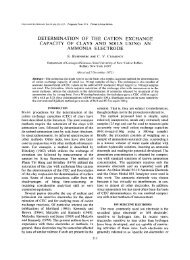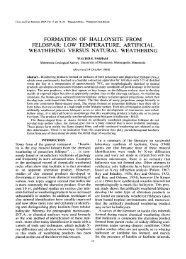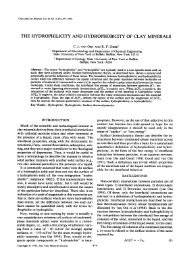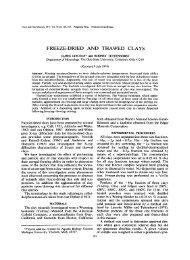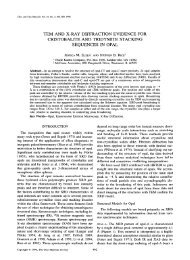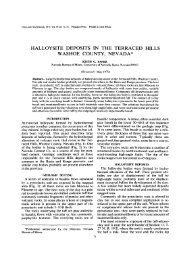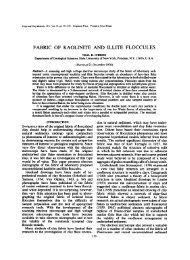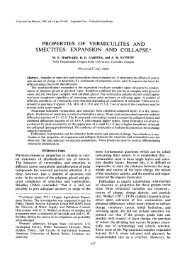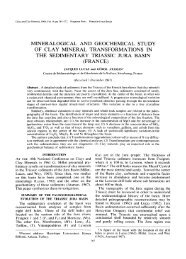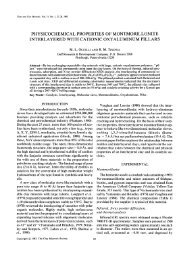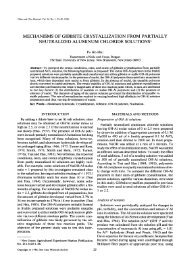MONTMORILLONITE DEPOSITS IN NEVADA* - Clay Minerals Society
MONTMORILLONITE DEPOSITS IN NEVADA* - Clay Minerals Society
MONTMORILLONITE DEPOSITS IN NEVADA* - Clay Minerals Society
You also want an ePaper? Increase the reach of your titles
YUMPU automatically turns print PDFs into web optimized ePapers that Google loves.
<strong>Clay</strong>s and <strong>Clay</strong> <strong>Minerals</strong>, 1969, Vol. 17, pp. 211-222. Pergamon Press. Primed in Great Britain<br />
<strong>MONTMORILLONITE</strong> <strong>DEPOSITS</strong><br />
<strong>IN</strong> <strong>NEVADA*</strong><br />
KEITH G. PAPKE<br />
Nevada Bureau of Mines, University of Nevada, Reno, Nevada 89107<br />
(Received 21 February 1969)<br />
Abstract-N evada has produced one-third million tons of montmorillonite clays; a major portion was<br />
natural adsorbent clay from the Ash Meadows district. Four properties, 3 with swelling and 1 with<br />
non-swelling montmorillonite, are currently producing.<br />
Detailed geologic and laboratory studies were made of thirty Nevada montmorillonite deposits.<br />
Pyroclastic and other volcanic rocks, mainly Miocene and Pliocene in age, were the host for most<br />
of these. The montmorillonite deposits are believed to have been formed in four ways: (1) eleven<br />
deposits by alteration of volcanic ash shortly after it settled in lacustrine basins; (2) two deposits by<br />
deposition of fine-grained clastic materials; (3) eleven deposits by hydrothermal alteration of a variety<br />
of rock types near structural channelways; and (4) six deposits by partial leaching and alteration of<br />
glassy, rhyolitic volcanic rocks by ground water.<br />
Montmorillonite is the predominant clay mineral in all the deposits except Ash Meadows, where<br />
saponite is present. Sodium is much more common as the exchangeable cation than calcium and/or<br />
magnesium. Kaolinite and illite are present in one-fifth of the samples; chlorite or mixed-layer material<br />
are rarely present. Quartz, cristobalite, feldspars, calcite, and gypsum are common impurities.<br />
The tests performed on the clay samples were: color; texture; slaking reaction; percentage swelling<br />
in water; plastic viscosity, yield point and gel strength of clay-water slurry; colloid content; and pH.<br />
Some montmorillonites formed by incomplete alteration of pyroclastic rocks can be wet separated<br />
to yield a light-colored, -- 2/z fraction with superior viscosity and thixotropy.<br />
<strong>IN</strong>TRODUCTION<br />
ALTHOUGH Nevada has produced one-third of<br />
a million tons of montmorillonite and many of the<br />
inactive deposits in the State are of possible<br />
economic interest, published information is limited<br />
to a few brief descriptions in bulletins by the<br />
Nevada Bureau of Mines, several short articles,<br />
and occasional references in U.S. government<br />
publications. For this reason a systematic study of<br />
the montmorillonite resources of Nevada seemed<br />
desirable, and the investigation summarized here<br />
was undertaken to obtain information on the dis-<br />
tribution, production, geology, mineralogy, and<br />
physical properties of the principal deposits.<br />
Detailed descriptions of these data for the individ-<br />
ual clay deposits, which are summarized here,<br />
can be found in a report by Papke (in press).<br />
About 60 montmorillonite deposits that appeared<br />
to have possibility of commercial utilization were<br />
examined and sampled. Some shale formations of<br />
Paleozoic or Mesozoic age and the numerous dry<br />
lake beds, where montmorillonite occurs with<br />
other clay minerals and abundant impurities,<br />
were not included. Half of the deposits examined<br />
*Publication authorized by the Director, Nevada<br />
Bureau of Mines.<br />
were judged to have inferior size, purity, or<br />
physical properties of the clay and were not studied<br />
further. Detailed geologic and laboratory examina-<br />
tions were made of the remaining 30 deposits<br />
which are in 11 of the State's 17 counties (Fig. 1).<br />
Field work on this project was done during<br />
1967 and 1968.<br />
PAST PRODUCTION, PRESENT PRODUCERS,<br />
TREATMENT, AND USES<br />
Production of montmorillonite clay was first<br />
reported from Nevada in 1918 (Middleton, 1921)<br />
and there has been production in most years<br />
since that time. in statistical summaries pub-<br />
lished annually by the U,S. government, tonnage<br />
information for individual states often was omit-<br />
ted and, prior to 1930, bentonite type of clay<br />
was included with miscellaneous clays. Based on<br />
the incomplete data available and field evidence,<br />
1 estimate that 268,000 short tons of fuller's<br />
earth (all of which consisted of montmorillonite<br />
group minerals) and 50,000 short tons of other<br />
montmorillonite clay have been produced. A<br />
large part of the fuller's earth came from the Ash<br />
Meadows district in southern Nye County, which<br />
had intermittent production from 1918 to 1925<br />
and continuous yearly production fiom 1925<br />
211
212 KEITH G. PAPKE<br />
HUMBOLDT<br />
el<br />
~------1 *WlNN(BUCCA<br />
X 2 -I<br />
qASHOE~t PERSH<strong>IN</strong>G L~'l'--<br />
i ?5 /<br />
I T"8 6<br />
. . . . 7 I .ELKO<br />
\<br />
ELKO<br />
| r ~/ ' CHURCHILL -" 9 }<br />
! ;,g" ("' / ...... I WHITE P<strong>IN</strong>E<br />
Ni~-~ L YoN\ . 13 ..(- . . . . . . -~<br />
~\ L] \. -\.<br />
PROPERTY ~ X ," \ N ~- I<br />
I. BOrret Springs , 9 18<br />
~R _ ~ ...... J ..<br />
H.ot~.g,oo -C;e.. \ / ~o "I r----- - ,9<br />
41 San Emid,o "x~" A.---- ; I "pl OC HI [<br />
Section 6 I<br />
8751 SectionS~ttiiO~ 62<br />
,<br />
~ ESMERALDA<br />
\<br />
J<br />
I<br />
I L<br />
,21<br />
,~'a;;'o~o~<br />
J ?<br />
.~.,<br />
14, WQlkef Lake I<br />
15. Mino<br />
16.<br />
Sodaville<br />
I<br />
24.<br />
4.2<br />
X 23<br />
Rhodes Marsh 9 5<br />
17. h 9 Prospec<br />
~ . . . . . . . .<br />
19 Bristol Silver x Post Producer (<br />
21, er<br />
22. a lot<br />
2&<br />
2T, Ash Meadows i<br />
28, Willow Tank<br />
29. V<br />
30. 3$tte Mountoinl -- --ScI~--~ fN z<br />
Cost~e Mounfalnl -- -- -- MiLl $ - z ~ X 3 0 I<br />
through 1952. The swelling montmorillonite came<br />
mostly from 5 open-pit mines and 1 underground<br />
mine, whose total productions ranged from 1000<br />
to 15,000 tons.<br />
Montmorillonite clays are currently produced<br />
from four Nevada deposits. Industrial <strong>Minerals</strong><br />
Co. mines a small tonnage of fuller's earth by open-<br />
pit method at the Jupiter property in Lyon County<br />
Fig. 1. Map showing montrnorillonite deposits in Nevada.<br />
and processes it at a mill in northern California.<br />
The clay was once used to purify petroleum and<br />
vegetable oils but is now used chiefly as a binder in<br />
feed pellets.<br />
All the swelling montmorillonite is produced by<br />
one company at three widely-separated mines.<br />
The Western Talc Co., a subsidiary of R. T.<br />
Vanderbilt Co., mines clays at the Blanco and Van-
derbilt properties by open-pit method and at the<br />
New Discovery property by underground, square-<br />
set stoping. The Blanco and New Discovery<br />
ores contain abundant feldspar and quartz, but<br />
the --2/z fraction is white and has superior<br />
viscosity and thixotropy. The Vanderbilt clay is<br />
purer and has lower viscosity and gel strength<br />
than the clays from the other two properties.<br />
The selectively-mined materials from the three<br />
properties are crushed and ground in a southern<br />
California mill. At a plant in Connecticut, the<br />
clays are blended, slurried with water, and pro-<br />
cessed to recover a fine-size fraction. Various<br />
blends of clays from the three Nevada deposits<br />
and two out-of-state deposits are used in different<br />
grades of Veegum, a brand product of the parent<br />
company. The powder or flake is used in numerous<br />
consumer products such as toothpaste, paint,<br />
floor polish, pharmaceuticals, cosmetics, and<br />
ceramics.<br />
GEOLOGY<br />
General<br />
Nevada is in the Basin and Range province,<br />
a region with north- to northeast-trending, elongated<br />
mountain ranges which are bordered by<br />
broad flat valleys. Almost all of the described<br />
montmorillonite deposits occur in the southern<br />
and western parts of the State (Fig. 1), where<br />
conditions apparently were favorable for the formation<br />
of these clays.<br />
Most of the montmorillonite bodies were derived<br />
from volcanic rocks, usually pyroclastic materials,<br />
of Tertiary or Quaternary age. Volcanic glass was<br />
identified in 1 or more samples from 15 of the<br />
deposits, and an igneous texture is retained by<br />
the clay in about one-half of the samples examined.<br />
The outcrop of a swelling montmorillonite in a<br />
dry climate usually has a distinctive, extensively<br />
cracked crust that results from repeated wetting<br />
and drying and consequent swelling and shrinking.<br />
In some Nevada deposits this crust is underlain<br />
by several inches of granular material that contains<br />
abundant soluble salts. Fragments of gypsum,<br />
or occasionally calcite, sometimes litter the<br />
surface. Many of the clay bodies are rather<br />
resistant to erosion and form low knolls or shoulders.<br />
Types of deposits<br />
The Nevada montmorillonite deposits have<br />
been divided into four genetic types: those formed<br />
by sedimentation and alteration in lakes; those<br />
formed by deposition of fine-grained clastics;<br />
those formed by hydrothermal alteration; and those<br />
formed by ground water alteration.<br />
<strong>MONTMORILLONITE</strong> <strong>DEPOSITS</strong> <strong>IN</strong> NEVADA 213<br />
1. Deposits formed by sedimentation and<br />
alteration in lakes. The deposits in this group<br />
were formed by alteration of volcanic ash shortly<br />
after it fell into alkaline lakes. The montmoril-<br />
Ionite beds are stratiform and are underlain and<br />
overlain by continental sedimentary rocks. The<br />
adjoining rocks usually are mudstone, shale, or<br />
siltstone; less commonly they are sandstone,<br />
conglomerate, or limestone. Most of the beds are<br />
nearly horizontal but dips as much as 45 ~ have<br />
been observed. The montmorillonite beds range<br />
in thickness from 2 to 20ft or more. The clays<br />
often contain small amounts of volcanic glass but<br />
residual tuffaceous textures are uncommon.<br />
Montmorillonite clays formed by the alteration<br />
of volcanic ash in situ are found throughout the<br />
world, and are particularly abundant in Tertiary<br />
rocks (Grim, 1968). Glassy volcanic ash is very<br />
susceptible to alteration to montmorillonite.<br />
The presence of some alkalis and alkaline earths<br />
are necessary for the conversion, and in particular<br />
the presence or introduction of magnesia probably<br />
is necessary for the formation of montmorillonite.<br />
When in excess of that required to form the clay,<br />
silica, alkalis, and calcium are liberated during<br />
the hydrolysis and devitrification of the glass<br />
and crystallization of the montmorillonite.<br />
Although it is believed that the ash settled<br />
directly in water prior to its alteration to clay,<br />
two other possibilities exist: (1) that the ash fell<br />
on land and was re-deposited in a lake before its<br />
conversion; (2) that pre-existing montmorillonitic<br />
clay was eroded and deposited in water, and the<br />
deposit more properly belongs to the clastic group<br />
described below. The small amount of detrital<br />
material in most of the samples is an argument<br />
against these possibilities, and especially against<br />
the second.<br />
The deposits formed by sedimentation and<br />
alteration of volcanic ash in lakes are Rosebud<br />
Canyon, Huntington Creek, Trinity, Lahontan,<br />
Broken Hills, Walker Lake, K-B, Ash Meadows,<br />
and Vanderbilt. The Barret Springs and Nixon<br />
deposits probably are in this group; they are<br />
almost completely concealed by alluvium but have<br />
been partly explored by drill holes.<br />
Figure 2 is a geologic map of the Rosebud<br />
Canyon property, an example of a stratiform<br />
deposit in sedimentary rocks. The montmoril-<br />
lonite bed is poorly exposed but it has a thickness<br />
of at least 4 ft and possibly as much as 8 ft. The<br />
adjacent rocks are clayey siltstone, siltstone<br />
and conglomerate. Small amounts of unaltered<br />
volcanic ash are present in the siltstones and<br />
montmorillonite.<br />
The adsorbent clay bodies of the Ash Meadows<br />
district, which furnished a substantial portion of
214 KEITH G. PAPKE<br />
) }<br />
, "'-:A6,,o'-L...-<br />
, , (<br />
\~'~ \ ,] ,,-<br />
9 ) }<br />
4600 . / ~<br />
g .....<br />
I Alluvium \<br />
In center pale redlsh brown clayey silts'~ane.<br />
Monlmor itlonile cloy<br />
Light olive gray clayey siltstone,<br />
Thin conglomerate in upper port.<br />
Pole reddish brown c~oyey siltslone<br />
,o FOUH ~ Contocf, dashed where<br />
~ approximately located.<br />
( ~<br />
~<br />
M=ne (lump<br />
Trench<br />
~.6 Strike and dip of beds.<br />
I00 0 200 FEET<br />
I0 FOOT CONTOUR <strong>IN</strong>TERVAL<br />
d.~.~:~ ~. ,,<br />
,~_~--::..:.: ....<br />
Fig. 2. Geologic map of the Rosebud Canyon montmorillonite deposit, Pershing County, Nevada.<br />
the total montmorillonite production, also are this<br />
type of deposit. Most of the tonnage came from<br />
two large open pits located on a low terrace<br />
that borders the west side of the Ash Meadows<br />
valley. The ore bodies in the district are circular<br />
in plan and lenticular, reflecting their deposition<br />
in shallow playa lakes during Pleistocene time.<br />
2. Deposits formed by deposition offine-grained<br />
cfastics. These deposits were formed by deposi-<br />
tion of mechanically-transported clayey detritus.<br />
They are geologically similar in some respects to<br />
the deposits formed by alteration of ash falls in<br />
lakes. The clastic deposits differ, however, in that<br />
they usually are thicker and of greater lateral<br />
extent; coarse, detrital quartz and feldspar are<br />
much more abundant and volcanic glass is absent.<br />
The principal source of the fine-grained clastic<br />
material was soil derived from volcanic rocks.<br />
The Rhodes Marsh and Willow Tank deposits<br />
were formed by clastic deposition. Montmoril-<br />
lonitic clay beds with the same origin are common<br />
in Nevada but most are too impure to be of econ-<br />
omic interest.<br />
3. Deposits formed by hydrothermal alteration.<br />
\
The deposits of this type were formed by the action<br />
of heated solutions that were derived, at least in<br />
part, from a magmatic source. The deposits differ<br />
from those in the other groups in that they were<br />
localized by structural features. Fault zones<br />
were the controlling structures for most of the<br />
clay bodies but contacts of basaltic intrusive<br />
bodies also were important in the Beatty deposits.<br />
The clay at the Bristol Silver mine is a fault<br />
gouge, but in the other hydrothermal deposits<br />
the clay was formed by the alteration of the wall<br />
rocks. The hydrothermal deposits are not restric-<br />
ted to glassy volcanic host rocks but they occur<br />
in volcanic flows, intrusive rock, and shale in<br />
addition to pyroclastic rock.<br />
The clay bodies commonly vary in the amount of<br />
impurities present, notably residual quartz and<br />
feldspar, and grade into the country rock. The<br />
montmorillonite usually replaces both feldspar<br />
and glass if both occur in the host rock. There is<br />
a wide range in the size, shape, and attitude of<br />
these deposits.<br />
Montmorillonite is a common hydrothermal<br />
mineral and it is generally believed to have formed<br />
in slightly alkaline conditions at a relatively low<br />
temperature. It is a typical mineral in the hydro-<br />
thermal alteration zone that surrounds some<br />
epigenetic metallic mineral bodies of the meso-<br />
thermal and epithermal types and in hot springs<br />
areas. Deposits of relatively pure montmorillonite<br />
not closely associated with metalliferous rocks<br />
or with active thermal areas, such as the deposits<br />
described here, probably are common in areas<br />
of hydrothermal activity and volcanism, but<br />
very few have been described in the literature.<br />
The deposits believed to be of hydrothermal<br />
origin are the San Emidio, Section 6, Section<br />
11, Jupiter, Sodaville, Bristol Well, Bristol Silver,<br />
Beatty, and New Discovery. The Section 8 and<br />
Roswell deposits, which occur in districts where<br />
several hydrothermal clay deposits are present,<br />
are also probably of hydrothermal derivation.<br />
Figure 3 is a geologic map and cross section of<br />
the Jupiter mine, in which a natural adsorbent<br />
clay was formed by hydrothermal solutions<br />
moving upward along a fault zone. On the hanging<br />
wall the montmorillonite has a gradational contact<br />
with a diorite porphyry flow. Occasional masses<br />
of partly-altered diorite porphyry in the ore body<br />
are evidence that this rock was the host for most,<br />
and perhaps all, of the clay material. The footwall<br />
of the montmorillonite is not exposed. The ore<br />
body has been displaced by several high-angle<br />
faults.<br />
4. Deposits Jbrrned by ground water alteration.<br />
These deposits are believed to have been formed<br />
by the alteration of volcanic rocks by ground<br />
<strong>MONTMORILLONITE</strong> <strong>DEPOSITS</strong> <strong>IN</strong> NEVADA 215<br />
waters where geologic or topographic conditions<br />
did not permit thorough leaching. Placing the de-<br />
posits in this group rather than in the hydro-<br />
thermal group, which they geologically resemble,<br />
was based mostly on two factors: their lack of<br />
any recognized local structural control; and their<br />
tendency to have a blanket-like form that is orien~<br />
ted in the plane of maximum permeability of<br />
the host rock.<br />
The host rocks for these deposits are ash-<br />
flow tuff, ash-fall tuff, perlite, and vesicular<br />
volcanic glass; all the rocks are of rhyolitic<br />
composition and probably predominantly glass.<br />
Most of these rocks were formed under conditions<br />
that precluded their deposition in standing water.<br />
The clay often has a gradational contact with the<br />
country rock and varies in the amounts of impur-<br />
ities.<br />
According to Keller (1966) volcanic ash on land<br />
tends to alter to montmorillonite in the same way<br />
that it does in water. Partly stagnant ground water<br />
is necessary to prevent the complete leaching of<br />
the alkalis and alkaline earths from permeable<br />
rocks. Calcium, sodium, and magnesium are re-<br />
leased during the hydrolysis of the unstable glass.<br />
These ions produce an alkaline environment<br />
around the glass particles and aid in the floccula-<br />
tion of silica, thus providing conditions that favor<br />
the development of montmorillonite. Other factors,<br />
such as host rock and ground water compositions<br />
and temperature, would influence the rate of re-<br />
action.<br />
In the Nevada Test Site in Nye County, ex-<br />
tensive bodies of zeolitized rock, which contain<br />
cristobalite and montmorillonite, were formed from<br />
unwelded tufts by mildly alkaline, meteoric waters<br />
(Gibbons, Hinrichs, and Botinelly, 1960). The<br />
zeolitized beds have irregular upper surfaces and<br />
occur immediately above relatively impermeable<br />
rocks, such as firmly-welded tufts, which are rarely<br />
altered to zeolites. The authors concluded that the<br />
alteration was accomplished in the vadose zone<br />
by ground waters whose downward circulation<br />
was impeded by the impermeable rocks. A some-<br />
what similar process is postulated for the mont-<br />
morillonite deposits of this group.<br />
The deposits believed formed by ground water<br />
are the Section 2, Mina, Blanco, Pahute Mesa,<br />
Sarcobatus Flat, and Castle Mountains. The<br />
Blanco, Pahute Mesa, and Sarcobatus Flat deposits<br />
are in unwelded ash-flow tufts; these are sheetlike<br />
bodies of nuge ardente origin. The Mina deposit is<br />
in an ash-fall tuff. A bed of perlite is the host for the<br />
Section 2 deposit. The Castle Mountains clay was<br />
derived from a frothy volcanic glass that probably<br />
solidified in a shallow intrusive body.<br />
The deposits were placed in this group because
216 KEITH G. PAPKE<br />
4560<br />
~ - *_-, T >~ .....<br />
ALLUVIUM AND DUMPS<br />
f<br />
MIOCENE-PLOCENE~<br />
F~l DIORITE PORPHYRY FLOW<br />
~'~ ANOESITE PORPHYRY FLOW<br />
HYDROTHERMAL <strong>MONTMORILLONITE</strong> CLAY<br />
FAULT, SHOW<strong>IN</strong>G DIP<br />
~. CONTACT, DASHED WHERE APPROXIMATEp<br />
DOTTED WHERE <strong>IN</strong>FERRED:, OIP SHOWN<br />
~, '~ OPEN PaT<br />
/<br />
!!!iiii!iii:i:::::::.~ ~ " v~;:.~;~J '~k:, :_~,"<br />
UfL'__ ~, ",<br />
, I00 0 300 FEET<br />
20 FOOT CONTOUR <strong>IN</strong>TERVAL<br />
Fig. 3. Geologic map and cross section of the Jupiter montmorillonite deposit, Lyon County, Nevada.<br />
of their form and their lack of recognized structural<br />
controls. It is possible that some of these deposits<br />
might have been formed by hydrothermal pro-<br />
cesses, especially the Section 2, Mina, and Castle<br />
Mountains deposits.<br />
The Blanco mine of Western Talc Co. is an ex-<br />
ample of a deposit formed by ground water.<br />
The host rock was an unwelded ash-flow tuff<br />
of Date Miocene or early Pliocene age. A rather<br />
homogeneous, montmorillonite-rich unit crops<br />
out in an area about 900 by 300 ft and is 20-45<br />
ft thick. Most of the glassy groundmass of the tuff<br />
was converted to montmorillonite but some<br />
quartz phenocrysts and lithic fragments were not<br />
altered.<br />
Age of deposits<br />
Except for those of clastic origin, the age of a<br />
clay deposit usually is difficult to determine,<br />
i
although the age of the host rock fixes the earliest<br />
possible date. Most of the Nevada montmoril-<br />
lonite deposits are either Tertiary or Quaternary<br />
in age. At least one-half of the deposits are in<br />
rocks regarded as Miocene or Pliocene. This was a<br />
time of extensive volcanic activity in the Basin<br />
and Range province, during which thick accumula-<br />
tions of both fragmental rocks and flows were<br />
formed.<br />
Five clay deposits may be pre-Tertiary in age.<br />
One occurs in a fault zone in Cambrian rocks,<br />
a second occurs in an igneous body that intrudes<br />
Devonian rocks, and a third was formed in shales<br />
of Triassic or Jurassic age. These three deposits<br />
were formed by hydrothermal processes; thus<br />
the clays may be much younger than the host<br />
rocks. Two deposits are in sedimentary rocks<br />
described as Cretaceous and Cretaceous or<br />
Tertiary.<br />
M<strong>IN</strong>ERALOGY AND PHYSICAL<br />
PROPERTIES OF THE CLAYS<br />
About ninety clay samples were taken from the<br />
deposits shown on Fig. 1. In most of the deposits,<br />
the typical clay is variable in both mineral com-<br />
position and physical properties. Therefore, a<br />
few samples cannot be used as a basis for the<br />
complete evaluation of a deposit. Tests made on<br />
the clay samples were:<br />
(a) Mineral composition of clay and non-clay<br />
fractions<br />
(b) physical properties: color; texture; slaking<br />
rate and type; percentage swelling; plastic vis-<br />
cosity; yield point; gel strength; percentage<br />
colloidal material; pH.<br />
Some pertinent physical and mineralogical<br />
data from these samples are summarized in Table 1.<br />
<strong>Clay</strong> minerals<br />
Representative samples from each of the de-<br />
posits were examined by microscopic and X-ray<br />
diffraction methods. The X-ray diffraction tech-<br />
nique was used on powder samples of the untreated<br />
clay and also on oriented slides of the -2/~<br />
fraction at conditions of 52 per cent relative<br />
humidity, after expansion with glycerol, and after<br />
heating at 550~ for 89 In addition, the +2~<br />
fraction from these samples was subjected to<br />
X-ray diffraction analysis. Differential thermal<br />
patterns also were made for a few samples.<br />
Members of the montmorillonite group are,<br />
by far, the most abundant clay minerals in all of<br />
the samples. The spacing of the 060 reflection<br />
provides a fairly reliable method for distinguishing<br />
between the dioctahedral and trioctahedral<br />
varieties of montmorillonite (MacEwan, 1949):<br />
The values range from about 1-490 to 1-515 A<br />
<strong>MONTMORILLONITE</strong> <strong>DEPOSITS</strong> <strong>IN</strong> NEVADA 217<br />
for the dioctahedral type and from about 1.515<br />
to 1.535 A for the trioctahedral type. On this basis,<br />
all but five of the Nevada samples are the diocta-<br />
hedra[ type; that is, they are either the alumina-<br />
rich montmorillonite member, or the iron-rich<br />
nontronite member. The low iron content, as in-<br />
dicated by the usual light color of the clay, suggests<br />
that almost all of them are aluminum-montmoril-<br />
lonite. The five exceptions with large 060 spacings<br />
probably are the trioctahedral mineral, saponite;<br />
the identification of saponite was partly confirmed<br />
by the Greene-Kelly test as outlined by MacEwan<br />
(1961). The five samples are natural adsorbent<br />
clay from the Ash Meadows district.<br />
For the untreated powder samples brought to<br />
equilibrium at 52 per cent relative humidity,<br />
the spacing of the 001 reflection of montmorillonite<br />
may give an indication whether the predominant<br />
exchangeable cation is sodium or calcium/mag-<br />
nesium (Mielenz, Schieltz, and King, 1955).<br />
If sodium is the principal exchangeable ion,<br />
the spacing is about 12.4 A; if calcium and/or<br />
magnesium are the principal exchangeable ions,<br />
the spacing is about 15.4~,. Mixtures of these<br />
cations give intermediate 001 values. Sodium<br />
may be confused with potassium and calcium<br />
or magnesium with hydrogen, but potassium<br />
and hydrogen are not common in natural clays.<br />
The predominant exchangeable cation could<br />
be estimated for 50 samples; about 75 per cent of<br />
these had sodium and 25 per cent had calcium<br />
and/or magnesium. The average swelling capacity,<br />
plastic viscosity, and gel strength of those with<br />
sodium was more than two times the averages<br />
for those with calcium and/or magnesium.<br />
Other clay minerals identified in the samples are<br />
kaolinite, illite, chlorite, and mixed-layer materials.<br />
These are listed on Table 1 in order of estimated<br />
abundance in a deposit. Kaolinite occurs in one-<br />
fifth of the samples but makes up more than a<br />
few per cent only in samples from three deposits.<br />
Kaolinite is more common in the deposits formed<br />
by hydrothermal alteration than in the other types<br />
of deposits. Illite was detected in small amounts<br />
in one-fifth of the samples. The presence of chlorite<br />
was verified in only three samples but some poorly<br />
crystalline material may have escaped detection.<br />
Mixed-layer clay in minor amounts was found in<br />
four samples of clays formed by alteration in<br />
lakes and by clastic deposition.<br />
Non-clay materials<br />
The non-clay materials detected in more than<br />
trace amounts are quartz, cristobalite, potash<br />
feldspar, plagioclase, calcite, gypsum, jarosite,<br />
pyrophyllite, clinoptilolite, hydrated iron oxides,<br />
and volcanic glass.
218 KE1TH G. PAPKE<br />
m<br />
E<br />
0<br />
--- r-.<br />
Z-.<br />
=<br />
. , . . .<br />
I I I I I I I 1 ~ 1 1 I I I I I I I I I I<br />
E<br />
~'d~ ~-= ~._=~ ~" ~<br />
~''v~6~Zt---.~m ~ ~ a . ~ m ~ Z ~,'<br />
~m<br />
H<br />
II<br />
..o<br />
II<br />
S~<br />
~A<br />
~v<br />
11 -~ o<br />
N ~<br />
lira= -<br />
V ~ ~<br />
9 ~-~<br />
~_~
Quartz is present in about 90 per cent of the<br />
samples. It is a serious contaminant, perhaps<br />
making up one-sixth or more of the rock, in<br />
15 per cent of the samples tested.<br />
Cristobalite occurs in about 40 per cent of the<br />
samples tested and probably comprises at least<br />
one-third of the material in 15 per cent of the<br />
samples tested. Although fine-grained cristo-<br />
balite is not unusual in montmorillonites, published<br />
data do not indicate that it is as abundant as<br />
shown in the Nevada samples. It probably is sig-<br />
nificant that the cristobalite is much more com-<br />
monly present and is more abundant in clays<br />
derived from thick sequences of volcanic rocks<br />
than in clays formed from thin ash falls in lakes.<br />
Most of the cristobalite apparently is moderately<br />
well crystallized, as indicated by a rather sharp<br />
101 peak that ranges from 4-01 to 4.08 A.<br />
Potash feldspar occurs in about 75 per cent<br />
and plagioclase in about 60 per cent of the samples.<br />
The feldspars are especially abundant in some<br />
samples of partly argillized pyroclastic rock,<br />
Calcite is present in about 40 per cent of the<br />
samples and gypsum in about 15 per cent.<br />
Physical properties<br />
All the samples were tested for the following:<br />
color; texture; slaking rate and type; percentage<br />
of swelling in water; and plastic viscosity, yield<br />
point, and gel strength of an 8 per cent clay<br />
slurry. Detailed study of the plastic viscosity,<br />
yield point, and gel strength was made for any<br />
sample with above-average plastic viscosity for<br />
the 8 per cent clay mixture. The percentage of<br />
colloidal material was determined for all samples<br />
that swelled 600 per cent or more. The pH of a<br />
clay-water mixture was measured for some<br />
samples.<br />
Color of the dried, pulverized montmorillonite<br />
was judged by comparison with the Rock-Color<br />
Chart (Geological <strong>Society</strong> of America, 1963).<br />
White or white with light tints are the most abun-<br />
dant colors, followed by very pale orange (10 YR<br />
8/2), yellowish gray (5Y 7/2, 5Y 8/1), grayish<br />
pink (5R 8/2) and pale pink (5RP 8/2). About<br />
three-fourths of the samples are of the above-<br />
named colors; most of the remainder are shades<br />
of yellow, orange, or brown.<br />
The texture of a majority of the clays are fine-<br />
grained and compact but some are earthy and<br />
friable. In a few instances the tuff host rock has<br />
been only partly altered and the material is rather<br />
hard.<br />
Approximately 40 per cent of the samples<br />
swelled but did not slake when a lump was placed<br />
in water. Most of the other samples slaked partly<br />
or completely to fines. Of the known adsorbent<br />
<strong>MONTMORILLONITE</strong> <strong>DEPOSITS</strong> <strong>IN</strong> NEVADA 219<br />
clays (Jupiter and Ash Meadows), five samples<br />
neither slaked or swelled and four slaked to chips.<br />
According to Nutting (1943) fuller's earth will not<br />
slake or swell but an activable clay will slake<br />
to chip-shaped granules.<br />
In the swelling test a volume measure of 3.5 cc<br />
was filled with unpacked pulverized clay. The<br />
contents were slowly added to a 100 ml graduated<br />
cylinder filled with distilled water, using a small<br />
spatula and allowing the individual particles<br />
to become wet and sink to the bottom. This<br />
procedure took as long as 5 min. The total volume<br />
of expanded clay at the bottom of the graduated<br />
cylinder was read after 24 hr and the percentage<br />
of swelling calculated. For example, a sample<br />
swelled 200 per cent if the final volume of clay<br />
was 10.5cc. Swelling ranged from 70 to 1800<br />
per cent.The natural adsorbent clays were among<br />
the lowest-swelling samples. The highest-swelling<br />
material was a hand-sorted, pure montmorillonite<br />
from the Beatty district. Two grades of a commer-<br />
cial product made partly from Nevada clays also<br />
were tested; Veegum swelled 755 per cent and<br />
Veegum T swelled 1000 per cent. Three samples<br />
of Wyoming bentonite from different producers<br />
swelled 785, 1275 and 1415 per cent.<br />
The plastic viscosity, yield point, and 10-min<br />
gel strength were measured with a Fann V-G<br />
viscometer (Savins and Roper, 1954), using an<br />
8 per cent clay mixture for all samples. This is<br />
a two-speed, rotational-type viscometer which has<br />
a rate of shear proportional to the revolutions<br />
per minute and a shearing stress proportional<br />
to the developed torque shown by a dial reading.<br />
The plastic viscosity and yield point were cal-<br />
culated from the torque values at both speeds.<br />
The gel strength of the mixture after ten minutes<br />
at rest was measured by a manual operation of<br />
the viscometer. The value for the plastic viscosity<br />
was plotted against the percentage of swelling for<br />
the sample and this chart was the basis for deter-<br />
mining whether or not a sample was of sufficient<br />
interest to be tested at other clay-water ratios.<br />
Figure 4 shows the results of plastic viscosity<br />
measurements for 14 samples, including a hand-<br />
sorted sample from Beatty, Veegum T, and a<br />
commercial Wyoming bentonite. As the plastic<br />
viscosity increases, the yield point and the 10-min<br />
gel strength also increase although the degree<br />
of correlation between the three values is only<br />
fair. Figure 5 illustrates the relationship of the<br />
yield point and the 10-min gel strength to the clay<br />
concentration for three Nevada samples.<br />
Samples from the Blanco and New Discovery<br />
mines, where the ore is partially-altered pyro-<br />
clastic rocks, were fractionated by wet sedimenta-<br />
tion technique and the -2/z portion recovered.
220 KEITH G. PAPKE<br />
60<br />
~so<br />
7-<br />
,.z,4o<br />
I-<br />
w<br />
m<br />
>20<br />
u<br />
~. ~o<br />
I I<br />
3 4<br />
J<br />
~/ sc<br />
/ ~/ ~'<br />
~ ~-5o<br />
~.i / :,/ o<br />
9 ~)4C<br />
//<br />
,/,2<br />
I I I I I I I I [<br />
6 7 8 9 I0 II 12 13 14<br />
PERCENT CLAY BY WEIGHT<br />
/<br />
P,/Y<br />
2 3 4 5 6 7 8 9 I0 II 12 1:3 14<br />
PERCENT CLAY BY WEIGHT<br />
Fig. 4. Variations of plastic viscosity with percentage of montmorillonite in clay-water mixtures for<br />
fourteen samples.<br />
I--<br />
u.<br />
8C<br />
O4(<br />
o<br />
0.<br />
I0 M<strong>IN</strong>UTE GEL STRENGTH /<br />
YIELD PO<strong>IN</strong>T //<br />
/!<br />
, ////<br />
------ --"<br />
t I I<br />
6 8 I0 12<br />
PERCENT CLAY BY WEIGHT<br />
Fig. 5. Variations of yield point and 10-min gel strength with per-<br />
centage of montmorillonite in clay-water mixtures for three Nevada<br />
samples.<br />
The sample from the Blanco deposit was 76 per<br />
cent -- 2 t~ and the sample from the New Discovery<br />
deposit was 42 per cent. Figure 6 shows the varia-<br />
tions in plastic viscosity for the original samples<br />
and the - 2/~ fractions.<br />
In the colloidal test 10.0g of dry, pulverized<br />
clay was dispersed in 400ml of distilled water<br />
for 24 hr. The slurry was stirred for 1 hr with an<br />
electric mixer, placed in a 500ml graduated<br />
cylinder, brought to 500ml with more water,<br />
thoroughly mixed by inverting the vessel, and<br />
allowed to settle. After 24hr the liquid was<br />
decanted down to 50 ml. The residue was dried<br />
and weighed; from this weight the percentage<br />
of material that had remained suspended in the<br />
decanted liquid was calculated. The graduated
6C ~ UNPROCESSEO SAMPLE<br />
LIJ M<strong>IN</strong>US TWO MICRON FRACTION<br />
13, .,7 /<br />
>2r<br />
F-<br />
<strong>MONTMORILLONITE</strong> <strong>DEPOSITS</strong> 1N NEVADA 221<br />
3 4 5 6 7 0 9 Io it Iz i3 14<br />
PERCENT CLAY BY WEIGHT<br />
Fig. 6. Variations of plastic viscosity with percentage of<br />
solids in clay-water mixtures for unprocessed samples<br />
and the - 2/x fractions.<br />
cylinder had a maximum particle fall of 263 mm;<br />
by Stokes' law the largest particle remaining in<br />
the decanted liquid had an equivalent spherical<br />
diameter of about 1.8/z. The percentage deter-<br />
mined obviously isnot strictly the colloidal<br />
content since the maximum diameter of a colloidal<br />
particle is much less than this. However, it is<br />
still a useful test for evaluating swelling mont-<br />
morillonite. For the 17 samples tested, the<br />
percentage of colloid ranged from 49 to 98 per<br />
cent. There was only a low correlation between<br />
the percentage of swelling and the colloidal<br />
content.<br />
The pH of a clay was measured in a mixture<br />
of 10.0g of dry sample and 100ml of distilled<br />
water after 1 hr aging. For the samples tested<br />
the values ranged from 4-6 to 11-1, but 80 per cent<br />
were between 8.0 and 10.5. According to Lamar<br />
(1953) some fuller's earths give an acid reaction in<br />
water. Three samples of adsorbent clay from the<br />
Jupiter deposit had values of 4-6-4.9 and four<br />
from the Ash Meadows district had values of<br />
8.9-9.8.<br />
Generally there is no correlation between the<br />
physical properties of the clays and the four<br />
genetic types of montmorillonite recognized during<br />
this study. Possible exceptions to this are: the<br />
high average values for swelling, plastic viscosity,<br />
and gel strength of clays formed by ground water;<br />
and the high pH of two clays formed by clastic<br />
deposition.<br />
Acknowledgments-I want to thank the companies and<br />
numerous individuals who aided me during the field work<br />
and preparation of the report and John Schilling and<br />
Arthur Baker 111 for critically reading the manuscript.<br />
REFERENCES<br />
Geological <strong>Society</strong> of America (1963) Rock-Color Chart:<br />
Geol. Soc. Am., New York.<br />
Gibbons, A. B., Hinrichs, E. N., and Botinelly, Theodore<br />
(1960) The role of impermeable rocks in controlling<br />
zeolitic alteration of tuff: U.S. Geol. Surv. Prof.<br />
Paper 400B, B473-475.<br />
Grim, R. E. (1968) <strong>Clay</strong> Mineralogy, 2nd edn: McGraw-<br />
Hill, New York.<br />
Keller, W. D. (1966) Geochemical weathering of rocks:<br />
source of raw materials for good living: J. Geol.<br />
Educ. 14, 17-22.<br />
Lamar, R. S. (1953) Adsorbent clays in California:<br />
Calif. J. Mines and Geol. 49, 297-337.<br />
MacEwan, D. M. C. (I 949) Some notes on the recording<br />
and interpretation of X-ray diagrams of soil clays:<br />
J. Soil Sci. 1, 90-103.<br />
MacEwan, D. M. C. (1961) Montmorillonite minerals<br />
in Brown (Editor) The X-ray Identification of <strong>Clay</strong><br />
<strong>Minerals</strong>: Mineral. Soc., London, 143-207.<br />
Middleton, Jefferson (1921) Fuller's earth: U.S. Geol.<br />
Surv., Mineral Resources U.S., 1918, Part II, 135-140.<br />
Mielenz, R. C., Schieltz, N. C., and King, M. E. (1955)<br />
Effect of exchangeable cation on X-ray diffraction<br />
patterns and thermal behavior of a montmorillonite<br />
clay: <strong>Clay</strong>s and <strong>Clay</strong> <strong>Minerals</strong> 3, 146-173.<br />
Nutting, P. G. (1943)Adsorbent clays: their distribution,<br />
properties, production, and use: U.S. Geol. Surv.<br />
Bull. 928-C.<br />
Papke, K. G. (1969) Montmorillonite, bentonite, and<br />
fullers earth deposits in Nevada: Nevada Bur. Mines<br />
Bull., In press.<br />
Savins, J. G., and Roper, W. F. (1954) A direct-indicating<br />
viscometer for drilling fluids: Am. Petrol. Inst., Drill-<br />
ing and Production Practice 7, 7-22.<br />
R~sum~-L'~tate de Nevada a fourni un tiers de million de tonnes d'argiles montmorillonites; une<br />
grande partie 6tait de l'argile naturelle adsorbante du district d'Ash Meadows. Quatre localit~s sont<br />
actuellement prodiutes: 3 avec montmorillonite gonflant et 1 avec montmorillonite non gonflant.<br />
Des ~tudes d&aill~es de g~ologie et de laboratoire ont ~t~ entreprises dans trente d~p6ts de mont-<br />
orillonite a l'6tate de Nevada. Les roches pyroclastiques et autres roches volcaniques, principalement<br />
du miocene et du plioc~ne en age, one re~u la plupart de ces d6p6ts, quie se seraient form6s de quatre<br />
mani~res: (1) onze d~p6ts par alteration de la cendre volcanique peu apr6s qu'elle se soit d~pos~e<br />
dans les bassins lacustres; (2) deux d~p6ts par s~dimentation de mat~riaux clastiques 5~ grains fins;<br />
(3) onze d6p6ts par alt6ration hydrothermique d'une vari&6 de types de roches proches des voles<br />
structurelles; et (4) six d6p6ts par filtration et alt6ration partielles de roches volcaniques rhyolitiques<br />
hyalines par l'eau de surface.
222 KEITH G. PAPKE<br />
ke montmorillonite est le mineral argileux qui pr6domine dans tousles d6p6ts 5- l'exception de celui<br />
d'Ash Meadows, o~ la saponite est prdsente. Le sodium est encore plus commun, en tant que cation<br />
d'6change, que le calcium et/ou le magn6sium. Le kaolin et l'illite sont pr6sents dans un cinqui~me<br />
des 6chantillon; le chlore ou les mati6res 5. couches mixtes sont rares. Le quartz, le cristobalite, le<br />
feldspath, le calcite, et le gypse sont des impuret6s communes.<br />
Les essais effectu6s sur les 6chantillons d'argile comprenaient les essais de couleur, de texture, de<br />
r6action de ralentissement, de pourcentage de gonflement dans I'eau, de viscosit6 plastique, de limite<br />
de r6sistance et de r6sistance au gel de la boue argile-eau, de la teneur en colloides et de pH. Quelques<br />
montmorillonites form6s par I'alt6ration incomplete de roches pyroclastiques peuvent ~tre s6par6s 5.<br />
l'6tat humide donnant une fraction de - 2/x 16g~rement color6e avec une thixotropie et une viscosit6<br />
sup6rieures.<br />
Kurzreferat- Nevada hat ein Drittel einer Million Tonnen Mon'tmorillonit Tone produziert, wobei der<br />
Grossteil aus natiirlichem, adsorbierendem Ton aus dem Ash Meadows Gebiet bestand. Vier Grud-<br />
stiicke, 3 mit quellendem und 1 mit nicht-quellendem Montmorillonit, sind derzeit in Produktion.<br />
Es wurden eingehende, geologische und Laboratoriumsstudien an dreissig Nevada Montmorillonit<br />
Lagerstiitten durchgefiihrt. In den meisten F~illen bestand alas Muttergestein aus pyroklastischem und<br />
anderem vulkanischem Gestein, haupts~ichlich mit Ursprung im Mioziin und Plioz~in. Es wird ange-<br />
nommen, dass sich die Montmorillonitlager auf vier Arten gebildet haben: (1) elf Lager dutch Veriin-<br />
derung vulkanischer Asche kurz nach Ablagerung in Binnenseebecken; (2) zwei Lager durch Ablager-<br />
ung feinki3rnigen, klastischen Materials; (3) elf Lager durch hydrothermale Ver~inderung verschiedener<br />
Gesteinsarten in der Niihe yon Rinnen im Gefiige; und (4) sechs Lager durch partielle Auslaugung und<br />
Ver~inderung von glasigem, rhyolitischem Vulkangestein durch Grundwasser.<br />
Montmorillonit ist das vorherrschende Tonmineral in all den Lagerst~.tten mit Ausnahme yon Ash<br />
Meadows, wo Saponit vorhanden ist. Natrium wird viel hiiufiger als austauschbares Kation angetroffen<br />
als Calcium bzw. Magnesium. Kaolinit und Illit sind in einem Fiinftel der Proben zugegen; Chlorit<br />
oder Mischschichtmaterial wird selten angetroffen. Quartz, Cristobalit, Feldspate, Calcit und Gips<br />
sind hiiufige Verunreinigungen.<br />
Die Tonproben wurden auf folgende Eigenschaften gepriift: Farbe; Gefiige; L6schreaktion;<br />
prozentuale Quellung in Wasser; plastische Viskosit~it; Fliessgrenze und Gelfestigkeit yon Ton-<br />
wasserschlamm; Kolloidgehalt; pH-Wert. Gewisse dutch unvollst~indige Wandlung pyroklastischen<br />
Gesteins gebildete Montmorillonite k/3nnen nass geschieden werden, so dass sie eine helle Fraktion<br />
yon weniger als 2/z mit hervorragenden Viskositiits- und Thixotropiemerkmalen ergeben.<br />
Pe3~oMe--B taT. HeBaaa ~O6blTO 1/3 MH~J1HOHa TOHH MOHTMOpHJ~Y[OHFITOBblX rJ1nu; r~aaHan Macca<br />
~x npeaacTaBJa~ex upnposHbl~ a~cop6e~x n npoHcxosnv ~3 paftoHa ~m: Mesoy3. B nacToamee<br />
apeMa Ha rpex MecTopo~aeHHaX ao6bmaexcn na6yxaromn~ n na Oa~OM- nena6yxarotun~<br />
MOHTMOpHYlYlOHHT. f][eTaabHblMH reonornqecKnMn n ~a6opaTopHb~MH ncc~eRoaanrl~Mn 6b1~n<br />
oxaaqenbl TpH511aTb MecTopo~SeHHfl MOHTMOpH.q~OHHTa. B 60.rlbHIHHCTBe H3 HI, IX MOHTMOpHa<br />
.rlOH!4TOBble FJIHHbl 3anera~ox B m,lpOK.qaCTHqecKHX H apyrnx By~KaHHtIeCKHX noposax,<br />
npeHMymecTaeHno MHotleHOBblX rl n.~HOHeHOablX.<br />
Pa3~nqaroTcfl qeTblpe nyxn o6pa3oBaHHfl MOHTMOI0HYlYlOHHTOBblX F.I1HH: 1. H3MeHeHne<br />
ByYlKaHI4'~eCKO~ 3OYlbl BCKOpe noc.rle ee oca~senHfl B o3epHblX 6acceflnax (OllHHHa,atlaTb MeCTOpo~lleHH~);<br />
2. OT~o;~eHHe TOHKOFO FYlHHHQTOFO 21eTpHTa (SBa MecTopo~KlleHnfl); 3. FHSpOTepMa~b-<br />
Hoe H3MeHeHHe pa3.qHqHblX hop05 OKO~O CTpyKTypHbJX KaHa~OB (OZIHHHa~UaTb MeCTOpO~senHfl);<br />
4. H3MeHeHHe 1"IO5 5eflCTBneM FIgyHTOBblX BOa CTeKYIOBaTblX pHO~rlTOBbIX ByJqKaHH'-IeCKrlX rlopo5<br />
npn OFpaHHtleHHOM BblHOCe OCHOBaHH~ (ILleCTb MecTopo~JleHH171).<br />
Flpeo6~asarotunM FYlHHHCTblM MHHepa.~OM Bcex MecTopo~seHl~n~ flBh~leTC~l MOHTMOpHJ'I.flOHHT;<br />
rO~b~O B ~)tU Me21oy3 Ha6~rosaercz canoHr~T. Haxpnfl, ~a~ O6MeHnbl~ KaTHOH, 6oaee O6bltleH,<br />
qeM KaJ'lblll, lJ~ H (HYlH) MaFHH~. O~Ha r~ITafl qaCTb o6pa3HoB COSep~l, IT Kaos~HHHT H n~qHT; X.rlOpllT<br />
n CMetUaHnOCJlO~Hb~e o6pa3OBaH~lfl na6n~osaroTcn pearo. K qrlc~y O~bltlHl~tx npnMece~ OTHOCflTC$1<br />
KBaptl, KDHCTO6a~HT, rlo.~eBMe tllnaTbL Ka.~bLtHT H rnnc.



